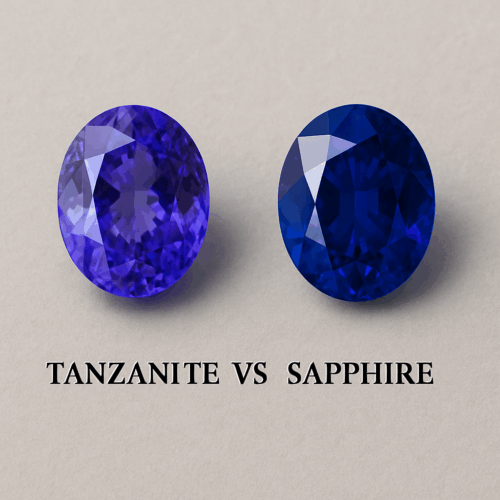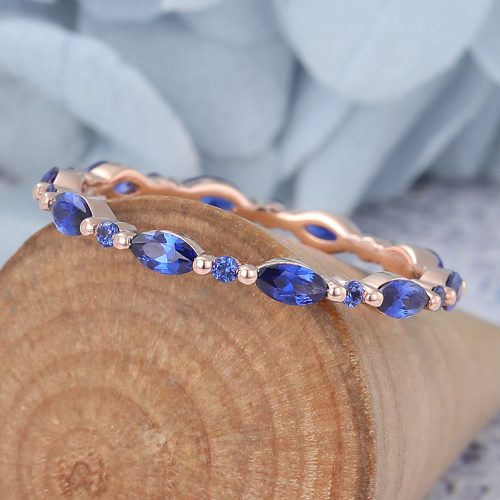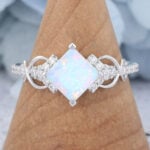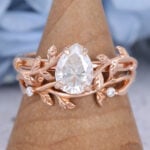Tanzanite vs Sapphire – What’s the Difference and Which Is Better for You?
When it comes to choosing the perfect blue gemstone, many people find themselves torn between tanzanite and sapphire. Both stones are stunning, rich in meaning, and widely used in fine jewelry. Whether you’re shopping for an engagement ring, a timeless pendant, or a meaningful gift, understanding the differences between Tanzanite vs Sapphire can help you make a more confident and personal decision. So how do you know which gem truly suits your style, values, and lifestyle? Let’s take a closer look.
Origin and Discovery
Tanzanite
Tanzanite was discovered in 1967 near Mount Kilimanjaro in Tanzania, the only known source in the world. Its sudden rise to fame was backed by Tiffany & Co., who helped name and promote it. Due to its limited origin, tanzanite is considered one of the rarest gemstones on the market today.
Sapphire
Sapphires have been valued for thousands of years, with major sources found in Sri Lanka, Myanmar, and Kashmir. These historic mines produced some of the world’s most iconic gems. Today, sapphires are also mined in Australia, Thailand, and Madagascar, making them more widely available than tanzanite.
Tanzanite vs Sapphire in Color and Visual Appeal
Tanzanite
Tanzanite displays a unique violet-blue hue that can shift depending on the lighting and viewing angle, a phenomenon known as pleochroism. In natural light, it may appear more blue, while under indoor light it takes on a purplish tone. This color-shifting quality gives tanzanite a mystical and romantic visual appeal, making it especially attractive to those seeking something vibrant and less traditional.
Sapphire
Sapphire is best known for its rich royal blue tone, though sapphire colors actually range from pale sky blue to deep velvety blue. Unlike tanzanite, sapphires tend to maintain a consistent hue under different lighting. Their clarity, brilliance, and depth of color give them a timeless elegance that suits both modern and classic jewelry designs.

Tanzanite vs Sapphire in Durability and Wearability
Tanzanite
Tanzanite ranks between 6 and 7 on the Mohs scale, making it softer than many other popular gemstones. The relatively low hardness of tanzanite means it can scratch or chip more easily, especially in rings or bracelets worn daily. For better longevity, tanzanite jewelry is often recommended for occasional wear or protected settings. The tanzanite mohs scale rating makes care and maintenance especially important.
Sapphire
Sapphire is one of the hardest natural gemstones, scoring a solid 9 on the Mohs scale. This exceptional durability makes it ideal for everyday jewelry like engagement rings or daily-wear earrings. Its resistance to scratching, breaking, or abrasion adds long-term value and practicality.
Tanzanite vs Sapphire in Symbolism and Meaning
Tanzanite
Tanzanite is often associated with transformation, intuition, and spiritual awakening. Its shifting colors reflect inner growth and emotional clarity, making it a favorite among those going through life changes or seeking deeper self-awareness. Many believe tanzanite stimulates higher consciousness and calms an overactive mind. As a modern birthstone for December, it carries a sense of renewal and forward movement, connecting its wearer to new beginnings and emotional healing.
Sapphire
Sapphire has long symbolized wisdom, loyalty, and inner strength. The meaning of sapphire gemstone often relates to truth, clarity, and spiritual protection. Historically worn by royalty and clergy, sapphire was believed to guard against negative energy and bring peace of mind. Today, it continues to represent sincerity and integrity, making it a popular choice for engagement rings and meaningful gifts. Its deep blue tone is seen as a reflection of trust, wisdom, and emotional depth.
Tanzanite vs Sapphire in Rarity and Sourcing Sustainability
Tanzanite
Tanzanite is found only in one small region of Tanzania, making it extremely rare and vulnerable to depletion. As demand grows, lab-created tanzanite has emerged as a sustainable alternative, offering the same beauty without environmental strain. Among tanzanite and sapphire, tanzanite remains rarer, but lab-grown options now offer a responsible path for conscious consumers.
Sapphire
Sapphires are more widely available, with natural sources in several countries and a long-standing tradition in fine jewelry. The rise of lab created sapphire has made it easier to source this gem ethically, with minimal environmental impact. When comparing tanzanite and sapphire, sapphire stands out for both availability and strong sustainability practices, especially through its high-quality lab-grown versions.


Tanzanite vs Sapphire in Price and Market Value
Tanzanite
Tanzanite is typically more affordable than sapphire, though high-quality stones can still be valuable. The price of 1 carat tanzanite generally ranges from $200 to $600 depending on clarity and color. Due to its rarity and single-source origin, prices may rise in the future. However, market demand is less stable compared to sapphire, and resale value can vary widely.
Sapphire
Sapphires tend to hold stronger long-term value, especially for stones with vivid color and few inclusions. The value of sapphire is supported by centuries of popularity and a broader resale market. High-quality sapphires can cost anywhere from $800 to over $5,000 per carat. Their durability and investment appeal make them a favored choice among collectors and jewelers.
Generational Preferences: Generation Z vs Classic Collectors
Tanzanite
Tanzanite appeals strongly to Gen Z and younger millennials who value individuality, spiritual meaning, and fresh aesthetics. Its rare color shift and limited origin feel unique and exclusive, aligning with the generation’s love for non-traditional, statement-making gems. Many also appreciate the availability of lab-grown options and ethical sourcing, which reflect Gen Z’s growing interest in sustainability and conscious consumption.
Sapphire
Sapphire remains a timeless favorite among classic collectors and older buyers who value heritage, prestige, and long-term investment. With its royal history and enduring symbolism, sapphire offers a sense of trust and tradition. Its proven market stability and high durability make it a logical choice for heirloom jewelry or engagement rings passed down through generations.
The Investment Mindset: Are You Buying Emotion or Equity?
Tanzanite
Tanzanite often appeals to buyers driven by emotion and uniqueness rather than long-term investment. Its rarity is attractive, but market demand can fluctuate, making its financial returns less predictable compared to more established gems.
Sapphire
Sapphire is widely recognized as a strong investment gem. Its durability, historical significance, and steady market demand make it a reliable choice for equity, often retaining or increasing value over time.
Conclusion
In the Tanzanite vs Sapphire comparison, both gems offer unique beauty and meaning. Your choice depends on whether you value rarity and color shift or durability and timeless appeal.
FAQs About Tanzanite vs Sapphire
Tanzanite vs Sapphire, Which Blue Gemstone Is Right for Engagements?
When choosing between tanzanite and sapphire for engagement rings, consider durability and style. Sapphire’s high hardness makes it ideal for everyday wear and lasting value. Tanzanite offers a unique color shift and rarity but requires more careful handling. Your choice depends on whether you prefer classic toughness or distinctive beauty.
Is tanzanite a gemstone? Is tanzanite sapphire?
Tanzanite is a genuine gemstone but it is not a sapphire. It belongs to the zoisite mineral family, while sapphire is a variety of corundum.
What color is sapphire? What does sapphire represent?
Sapphire is typically known for its deep blue color, though it comes in various colors. It represents wisdom, loyalty, and protection.
Is tanzanite expensive? How expensive is tanzanite? How much are tanzanites worth?
Tanzanite can be moderately expensive. Prices vary but quality stones often range from $200 to $600 per carat depending on size and color.
How hard is tanzanite? How rare is a sapphire?
Tanzanite rates about 6–7 on the Mohs scale, making it less hard than sapphire. Sapphire is rarer in some colors but generally more abundant overall.
Are sapphires hard? How hard are sapphires?
Yes, sapphires are very hard, rating 9 on the Mohs scale, making them highly durable for everyday wear.
Is sapphire expensive? How much are sapphires worth? Are purple gemstones more valuable than blue gemstones?
Sapphires can be quite expensive, especially high-quality blue ones, ranging from $800 to over $5,000 per carat. Purple gems’ value depends on type; some rare purple stones may be more valuable than common blue gems.
 Christmas: 25% off All ltems · Code AFJ25 ·Ends Dec 30 30% off All Items ·On Orders Over $600 – Code AMANDA30
Christmas: 25% off All ltems · Code AFJ25 ·Ends Dec 30 30% off All Items ·On Orders Over $600 – Code AMANDA30


